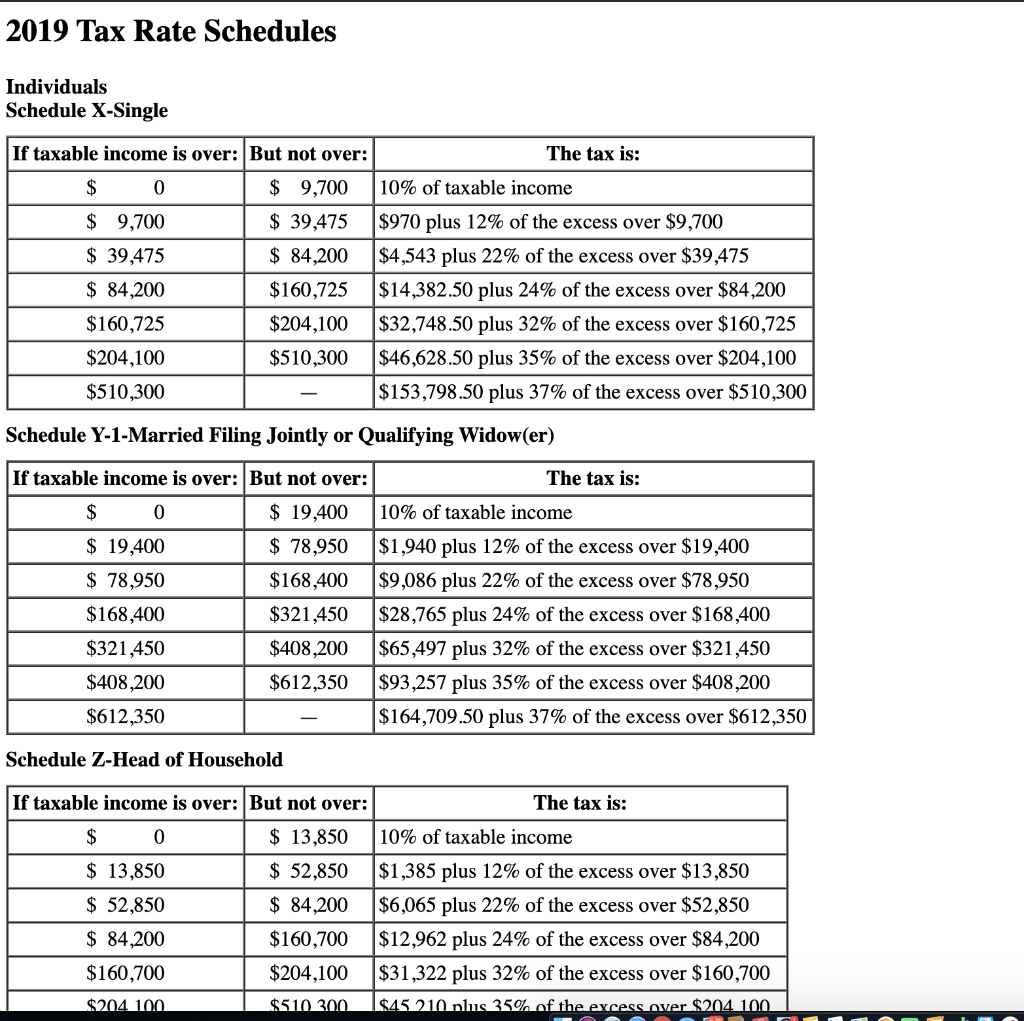Santinis new contract for 2019 indicates the following compensation and benefits:
| Benefit Description | Amount |
| Salary | $ | 136,000 |
| Health insurance | | 15,000 |
| Restricted stock grant | | 2,500 |
| Bonus | | 6,200 |
| Hawaii trip | | 5,200 |
| Group-term life insurance | | 2,800 |
| Parking ($319 per month) | | 3,828 |
| |
Santini is 54 years old at the end of 2019. He is single and has no dependents. The restricted stock grant is 500 shares granted when the market price was $5 per share. Assume that the stock vests on December 31, 2019, and that the market price on that date is $37.50 per share. Also assume that Santini is willing to make any elections to reduce equity-based compensation taxes. The Hawaii trip was given to him as the outstanding salesperson for 2018. The group-term life policy gives him $150,000 of coverage. Assume that Santini does not itemize deductions for the year.
Determine Santini's taxable income and income tax liability for 2019. Use Tax rate schedules and Exhibit 12-8. (Round your answers to the nearest whole dollar amount. Leave no answer blank. Enter zero if applicable.)


2019 Tax Rate Schedules Individuals Schedule X-Single If taxable income is over: But not over: The tax is: $ 0 $ 9,700 10% of taxable income $ 9,700 $ 39,475 $ 84,200 $160,725 $ 39,475 $ 84,200 $160,725 $204,100 $510,300 $970 plus 12% of the excess over $9,700 $4,543 plus 22% of the excess over $39,475 $14,382.50 plus 24% of the excess over $84,200 $32,748.50 plus 32% of the excess over $160,725 $46,628.50 plus 35% of the excess over $204,100 $153,798.50 plus 37% of the excess over $510,300 $204,100 $510,300 Schedule Y-1-Married Filing Jointly or Qualifying Widow(er) If taxable income is over: But not over: The tax is: $ 0 10% of taxable income $ 19,400 $ 78,950 $168,400 $321,450 $408,200 $612,350 $ 19,400 $ 78,950 $168,400 $321,450 $408,200 $612,350 $1,940 plus 12% of the excess over $19,400 $9,086 plus 22% of the excess over $78,950 $28,765 plus 24% of the excess over $168,400 $65,497 plus 32% of the excess over $321,450 $93,257 plus 35% of the excess over $408,200 $164,709.50 plus 37% of the excess over $612,350 Schedule Z-Head of Household The tax is: If taxable income is over: But not over: $ 0 $ 13,850 $ 13,850 $ 52,850 $ 52,850 $ 84,200 $ 84,200 $160,700 $160,700 $204,100 $204 100 $510 300 10% of taxable income $1,385 plus 12% of the excess over $13,850 $6,065 plus 22% of the excess over $52,850 $12,962 plus 24% of the excess over $84,200 $31,322 plus 32% of the excess over $160,700 $45 210 nlus 35% of the excess over $204 100 Schedule Y-1-Married Filing Jointly or Qualifying Widow(er) The tax is: If taxable income is over: But not over: $ 0 $ 19,400 $ 19,400 $ 78,950 $ 78,950 $168,400 $168,400 $321,450 $321,450 $408,200 $408,200 $612,350 $612,350 10% of taxable income $1,940 plus 12% of the excess over $19,400 $9,086 plus 22% of the excess over $78,950 $28,765 plus 24% of the excess over $168,400 $65,497 plus 32% of the excess over $321,450 $93,257 plus 35% of the excess over $408,200 $164,709.50 plus 37% of the excess over $612,350 Schedule Z-Head of Household The tax is: If taxable income is over: But not over: $ 0 $ 13,850 $ 13,850 $ 52,850 $ 52,850 $ 84,200 $ 84,200 $160,700 $160,700 $204,100 $204,100 $510,300 $510,300 10% of taxable income $1,385 plus 12% of the excess over $13,850 $6,065 plus 22% of the excess over $52,850 $12,962 plus 24% of the excess over $84,200 $31,322 plus 32% of the excess over $160,700 $45,210 plus 35% of the excess over $204,100 $152,380 plus 37% of the excess over $510,300 Schedule Y-2-Married Filing Separately If taxable income is over: But not over: The tax is: $ 0 $ 9,700 $ 9,700 $ 39,475 $ 84,200 $ 39,475 $ 84,200 $160,725 $204,100 $160,725 $204,100 $306,175 10% of taxable income $970 plus 12% of the excess over $9,700 $4,543 plus 22% of the excess over $39,475 $14,382.50 plus 24% of the excess over $84,200 $32,748.50 plus 32% of the excess over $160,725 $46,628.50 plus 35% of the excess over $204,100 $82,354.75 plus 37% of the excess over $306,175 $306,175








